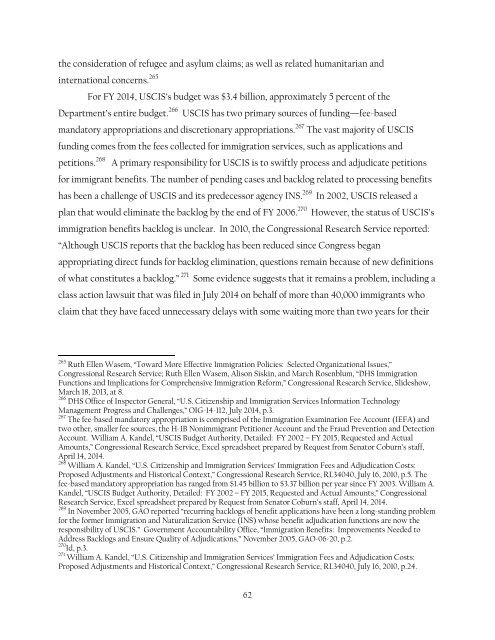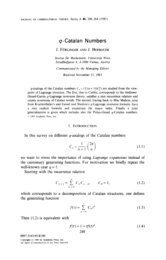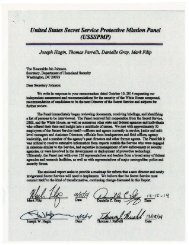010815as1
Create successful ePaper yourself
Turn your PDF publications into a flip-book with our unique Google optimized e-Paper software.
the consideration of refugee and asylum claims; as well as related humanitarian and<br />
international concerns. 265<br />
For FY 2014, USCIS’s budget was $3.4 billion, approximately 5 percent of the<br />
Department’s entire budget. 266 USCIS has two primary sources of funding—fee-based<br />
mandatory appropriations and discretionary appropriations. 267 The vast majority of USCIS<br />
funding comes from the fees collected for immigration services, such as applications and<br />
petitions. 268 A primary responsibility for USCIS is to swiftly process and adjudicate petitions<br />
for immigrant benefits. The number of pending cases and backlog related to processing benefits<br />
has been a challenge of USCIS and its predecessor agency INS. 269 In 2002, USCIS released a<br />
plan that would eliminate the backlog by the end of FY 2006. 270 However, the status of USCIS’s<br />
immigration benefits backlog is unclear. In 2010, the Congressional Research Service reported:<br />
“Although USCIS reports that the backlog has been reduced since Congress began<br />
appropriating direct funds for backlog elimination, questions remain because of new definitions<br />
of what constitutes a backlog.” 271 Some evidence suggests that it remains a problem, including a<br />
class action lawsuit that was filed in July 2014 on behalf of more than 40,000 immigrants who<br />
claim that they have faced unnecessary delays with some waiting more than two years for their<br />
265 Ruth Ellen Wasem, “Toward More Effective Immigration Policies: Selected Organizational Issues,”<br />
Congressional Research Service; Ruth Ellen Wasem, Alison Siskin, and March Rosenblum, “DHS Immigration<br />
Functions and Implications for Comprehensive Immigration Reform,” Congressional Research Service, Slideshow,<br />
March 18, 2013, at 8.<br />
266 DHS Office of Inspector General, “U.S. Citizenship and Immigration Services Information Technology<br />
Management Progress and Challenges,” OIG-14-112, July 2014, p.3.<br />
267 The fee-based mandatory appropriation is comprised of the Immigration Examination Fee Account (IEFA) and<br />
two other, smaller fee sources, the H-1B Nonimmigrant Petitioner Account and the Fraud Prevention and Detection<br />
Account. William A. Kandel, “USCIS Budget Authority, Detailed: FY 2002 – FY 2015, Requested and Actual<br />
Amounts,” Congressional Research Service, Excel spreadsheet prepared by Request from Senator Coburn’s staff,<br />
April 14, 2014.<br />
268 William A. Kandel, “U.S. Citizenship and Immigration Services’ Immigration Fees and Adjudication Costs:<br />
Proposed Adjustments and Historical Context,” Congressional Research Service, RL34040, July 16, 2010, p.5. The<br />
fee-based mandatory appropriation has ranged from $1.45 billion to $3.37 billion per year since FY 2003. William A.<br />
Kandel, “USCIS Budget Authority, Detailed: FY 2002 – FY 2015, Requested and Actual Amounts,” Congressional<br />
Research Service, Excel spreadsheet prepared by Request from Senator Coburn’s staff, April 14, 2014.<br />
269 In November 2005, GAO reported “recurring backlogs of benefit applications have been a long-standing problem<br />
for the former Immigration and Naturalization Service (INS) whose benefit adjudication functions are now the<br />
responsibility of USCIS.” Government Accountability Office, “Immigration Benefits: Improvements Needed to<br />
Address Backlogs and Ensure Quality of Adjudications,” November 2005, GAO-06-20, p.2.<br />
270 Id, p.3.<br />
271 William A. Kandel, “U.S. Citizenship and Immigration Services’ Immigration Fees and Adjudication Costs:<br />
Proposed Adjustments and Historical Context,” Congressional Research Service, RL34040, July 16, 2010, p.24.<br />
62








![55721335-d6fe09eb5ffdcc87dbf6c3f0b5bbda07d2261e98[1]](https://img.yumpu.com/56533583/1/186x260/55721335-d6fe09eb5ffdcc87dbf6c3f0b5bbda07d2261e981.jpg?quality=85)








